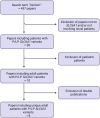The phenotypic presentation of adult individuals with SLC6A1-related neurodevelopmental disorders
- PMID: 37662110
- PMCID: PMC10472133
- DOI: 10.3389/fnins.2023.1216653
The phenotypic presentation of adult individuals with SLC6A1-related neurodevelopmental disorders
Abstract
Introduction: SLC6A1 is one of the most common monogenic causes of epilepsy and is a well-established cause of neurodevelopmental disorders. SLC6A1-neurodevelopmental disorders have a consistent phenotype of mild to severe intellectual disability (ID), epilepsy, language delay and behavioral disorders. This phenotypic description is mainly based on knowledge from the pediatric population.
Method: Here, we sought to describe patients with SLC6A1 variants and age above 18 years through the ascertainment of published and unpublished patients. Unpublished patients were ascertained through international collaborations, while previously published patients were collected through a literature search.
Results: A total of 15 adult patients with SLC6A1 variants were included. 9/13 patients had moderate to severe ID (data not available in two). Epilepsy was prevalent (11/15) with seizure types such as absence, myoclonic, atonic, and tonic-clonic seizures. Epilepsy was refractory in 7/11, while four patients were seizure free with lamotrigine, valproate, or lamotrigine in combination with valproate. Language development was severely impaired in five patients. Behavioral disorders were reported in and mainly consisted of autism spectrum disorders and aggressive behavior. Schizophrenia was not reported in any of the patients.
Discussion: The phenotype displayed in the adult patients presented here resembled that of the pediatric cohort with ID, epilepsy, and behavioral disturbances, indicating that the phenotype of SLC6A1-NDD is consistent over time. Seizures were refractory in >60% of the patients with epilepsy, indicating the lack of targeted treatment in SLC6A1-NDDs. With increased focus on repurposing drugs and on the development of new treatments, hope is that the outlook reflected here will change over time. ID appeared to be more severe in the adult patients, albeit this might reflect a recruitment bias, where only patients seen in specialized centers were included or it might be a feature of the natural history of SLC6A1-NDDs. This issue warrants to be explored in further studies in larger cohorts.
Keywords: SLC6A1; epilepsy; epilepsy genetics; intellectual disability; neurodevelopmental disorders.
Copyright © 2023 Johannesen, Nielsen, Sabers, Isidor, Kattentidt-Mouravieva, Zieglgänsberger, Heidlebaugh, Oetjens, Vidal, Christensen, Tiller, Freed, Møller and Rubboli.
Conflict of interest statement
The authors declare that the research was conducted in the absence of any commercial or financial relationships that could be construed as a potential conflict of interest.
Similar articles
-
Defining the phenotypic spectrum of SLC6A1 mutations.Epilepsia. 2018 Feb;59(2):389-402. doi: 10.1111/epi.13986. Epub 2018 Jan 8. Epilepsia. 2018. PMID: 29315614 Free PMC article.
-
Behavioral, neurodevelopmental profile, and epilepsy trajectory in two series of SLC6A1-NDD: A retrospective study with comprehensive assessment, and a participatory database study.Eur J Paediatr Neurol. 2025 Jan;54:121-129. doi: 10.1016/j.ejpn.2025.01.003. Epub 2025 Jan 10. Eur J Paediatr Neurol. 2025. PMID: 39889538
-
Intrafamilial variability in SLC6A1-related neurodevelopmental disorders.Front Neurosci. 2023 Jul 12;17:1219262. doi: 10.3389/fnins.2023.1219262. eCollection 2023. Front Neurosci. 2023. PMID: 37502687 Free PMC article.
-
Current knowledge of SLC6A1-related neurodevelopmental disorders.Brain Commun. 2020 Oct 13;2(2):fcaa170. doi: 10.1093/braincomms/fcaa170. eCollection 2020. Brain Commun. 2020. PMID: 33241211 Free PMC article. Review.
-
Use of antiepileptic drugs in the treatment of epilepsy in people with intellectual disability.J Intellect Disabil Res. 1998 Dec;42 Suppl 1:1-15. J Intellect Disabil Res. 1998. PMID: 10030426 Review.
Cited by
-
A transporter's doom or destiny: SLC6A1 in health and disease, novel molecular targets and emerging therapeutic prospects.Front Mol Neurosci. 2024 Aug 29;17:1466694. doi: 10.3389/fnmol.2024.1466694. eCollection 2024. Front Mol Neurosci. 2024. PMID: 39268250 Free PMC article. Review.
-
Causative Role of the SLC6A1 p.Asp451Gly Variant in a Patient with Combined Dystonia and Neurodevelopmental Disorder.Mov Disord Clin Pract. 2025 Feb;12(2):239-241. doi: 10.1002/mdc3.14246. Epub 2024 Oct 24. Mov Disord Clin Pract. 2025. PMID: 39446029 Free PMC article. No abstract available.
-
Amino Acid Compound 2 (AAC2) Treatment Counteracts Insulin-Induced Synaptic Gene Expression and Seizure-Related Mortality in a Mouse Model of Alzheimer's Disease.Int J Mol Sci. 2024 Oct 30;25(21):11689. doi: 10.3390/ijms252111689. Int J Mol Sci. 2024. PMID: 39519239 Free PMC article.
-
Transiently elevated expression of different forms of brain-derived neurotrophic factor in the neonatal medial prefrontal cortex affected anxiety and depressive-like behaviors in adolescence.PeerJ. 2024 Nov 27;12:e18465. doi: 10.7717/peerj.18465. eCollection 2024. PeerJ. 2024. PMID: 39619203 Free PMC article.
References
LinkOut - more resources
Full Text Sources


